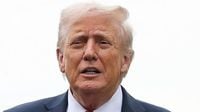As the U.S. government ground to a halt in late September 2025, the nation witnessed a new low in political brinkmanship—one where artificial intelligence, racial stereotypes, and trolling memes replaced traditional negotiation tactics. President Donald Trump, never one to shy away from controversy, unleashed a barrage of AI-generated videos and memes targeting Democratic leaders, particularly House Minority Leader Hakeem Jeffries and Senate Minority Leader Chuck Schumer, as the deadline for a government shutdown loomed.
It all began on the night of September 29, 2025, when President Trump posted a 35-second AI-generated deepfake video to his Truth Social account. The video, as reported by Ars Technica, was laced with crude insults, racial overtones, and conspiracy theories. In the clip, a deepfake version of Senator Schumer delivers a surreal monologue, while a digitally altered Jeffries appears in a CGI sombrero and fake mustache, with mariachi music blaring in the background. The video’s message was as unsubtle as its visuals: Democrats, it claimed, were desperate for votes and willing to offer free health care to undocumented immigrants in exchange for political support—a claim Democrats flatly denied.
Trump’s use of AI deepfakes, described by Ars Technica as “vulgar” and “racially tinged,” was not a one-off. The following day, he doubled down by posting a second video, this time splicing footage of Jeffries condemning the original video on MSNBC with more sombrero memes and an all-Trump mariachi band. According to New York Magazine, these posts were amplified across social media, including X (formerly Twitter), ensuring maximum visibility for the president’s trolling tactics.
The memes didn’t stop at Jeffries. The Trump War Room X account shared an AI-generated image of Democratic Representative Maxine Waters, another Black lawmaker, similarly decked out in stereotypical Mexican attire—a move widely condemned as racist. As The New Republic noted, the use of such stereotypes to mock politicians, regardless of their actual heritage, was “inherently racist.” Yet the White House appeared unfazed. Footage of Democrats opposing previous shutdowns played on a loop in the press briefing room, and Trump’s son, Don Jr., joined in the online mockery, threatening to post more sombrero images if Democrats didn’t comply with Republican demands.
In the midst of this digital onslaught, the stakes couldn’t have been higher. The government was on the brink of its first shutdown in nearly seven years, with mass layoffs and disruptions to federal services looming. Yet, instead of hammering out a compromise, Trump’s strategy seemed focused on shifting blame and pressuring Democrats through ridicule. As Dawn reported, Trump’s approach was “don’t negotiate, threaten mass layoffs and hope the Democrats cave in.”
The trolling extended into the real world as well. During a high-stakes Oval Office meeting with Schumer and Jeffries, Trump staged another spectacle: red “Trump 2028” hats, referencing a constitutionally forbidden third term, appeared on the iconic Resolute Desk. Jeffries later told CNN that the hats “just randomly appeared in the middle of the meeting on the desk. It was the strangest thing ever.” When Jeffries questioned Vice President JD Vance—seated to his left—about the hats, Vance offered a terse “No comment.”
Jeffries, who is African American and the first Black man to lead a major party in either chamber of Congress, was unequivocal in his response to the AI-generated videos. Appearing on MSNBC, he called Trump’s post “disgusting” and vowed, “We’re going to continue to make clear bigotry will get you nowhere.” Representative Madeleine Dean confronted House Speaker Mike Johnson about the videos, but his only response was, “I think it wasn’t my style.”
Vice President Vance, for his part, attempted to deflect criticism with humor. Speaking at a White House press briefing on October 1, Vance said, “Oh, I think it’s funny! The president’s joking and we’re having a good time. You can negotiate in good faith while poking a little bit of fun at some of the absurdities [in] some of the Democrats’ positions. And even poking some fun at the absurdity of the Democrats themselves.” He went further, promising Jeffries, “if you help us reopen the government the sombrero memes will stop.” Vance also questioned the accusation of racism, saying, “Hakeem Jeffries said it was racist. And I know that he said that, and I honestly don’t even honestly know what that means. Like, is he a Mexican American that is offended by having, like, a sombrero meme?”
This attitude—dismissing concerns about racism as overblown or irrelevant—was echoed by some on the right. Michael LaRosa, a former spokesperson for Jill Biden, quipped on X, “If you can’t laugh at this, then you epitomize the problem with the Democratic Party these days. Let’s all lighten up a bit.” California Governor Gavin Newsom, for his part, responded with a jab of his own: “Trump always chickens out (TACO). No sombrero needed!”
But for many, the use of AI to manufacture racist caricatures and spread misinformation marked a new and dangerous escalation. Ars Technica warned that the proliferation of deepfakes threatens the very foundation of truth in public life, allowing bad actors to dismiss even genuine events as “fake news.” In the political realm, the risks are especially acute—deepfakes can make any politician say or do anything, eroding trust in both leaders and institutions.
Amid the uproar, a Siena/New York Times poll conducted from September 22 to 27 found that blame for the shutdown was spread across the political spectrum: 19 percent of respondents blamed Democrats in Congress, 26 percent blamed Trump and Republicans, 33 percent blamed both equally, and 21 percent said they hadn’t heard enough to say. This suggests that, at least for now, Trump’s meme-driven strategy hasn’t decisively shifted public opinion in his favor—but it has certainly deepened the polarization and distracted from the substantive issues at stake.
As the shutdown dragged on, the spectacle of AI-generated insults, racially charged memes, and trolling stunts underscored a stark reality: the nation’s most powerful leaders were more interested in scoring points online than solving the real-world problems facing millions of Americans. In the end, the line between political theater and responsible governance seemed blurrier than ever.






